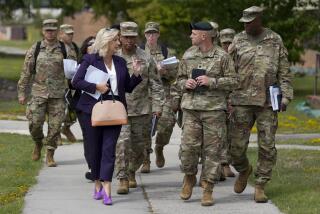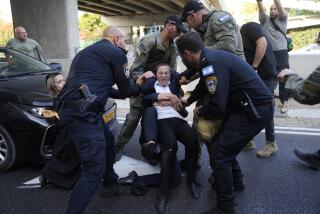America Has No Need for a New Draft
WASHINGTON â The U.S. militaryâs All-Volunteer Force has been working--and working well--for 14 years, but arguments for a draft refuse to disappear. Indeed, many Democrats, including Sen. Sam Nunn (D-Ga.), chairman of the Senate Armed Services Committee and a potential presidential candidate, hope to use conscription as a cheap way of demonstrating âtoughnessâ on defense.
Meanwhile, most Pentagon officials seem pleased with the volunteer force. The Army chief of staff, Gen. John A. Wickham Jr., says simply, âthe volunteer system is working.â A return to the draft, many officers fear, would reduce the quality of recruits and destroy public support for the military.
And theyâre right. The volunteer system will face future challenges but the fact that maintaining it will take work does not mean it should be abandoned. We should be wary of turning back to conscription, said a former Marine Corps officer, Lt. Col. David Evans, because âtoday the volunteer military has all the attributes of a truly professional standing military: quality, experience and stability.â
That voluntarism has worked should come as no surprise, for in no other occupation, service or profession are people conscripted. The military is dangerous, of course, but that does not make it unique. Police are shot in the line of duty, firemen die fighting fires and steeple-jacks fall off skyscrapers.
Indeed, America has always had a volunteer officer corps and career enlisted force, having relied on voluntarism to man the entire military for all but 38 years of the nationâs history. It took a wrenching Civil War to inaugurate conscription in America and two world wars to institutionalize the practice.
Yet the political appeal of involuntary service never seems to fade. Perhaps the most fundamental attack on the volunteer force is on the grounds that it neglects the principle that citizenship carries burdens as well as benefits. The âprivilegeâ of being an American, some argue, justifies requiring men to serve in the military.
This contention implies, however, that government is the grantor, rather than protector, of rights--fundamentally misconstruing the relationship between the individual and the state in a free society. It is a privilege to be an American in the sense that one is lucky to live in a country that respects individual liberty more than most others, not in the sense that the government is bestowing unearned freedom benefits on the citizenry.
Even if citizens do owe service to the state, why are only young men liable? Conscription disproportionately burdens 18-year-old men. In contrast, a volunteer military financed by universal taxation--a far less intrusive and destructive form of coercion than a draft--spreads the defense obligation throughout society.
Perhaps the most misleading objection to the All-Volunteer Force is that it is âtoo expensive.â But a draft wouldnât lower federal costs. Roughly 90% of all spending on military compensation goes to careerists, civilians and retirees. If the Pentagon slashed recruit pay by one-third, outlays would fall a mere $2 billion; any savings would be offset by increased costs elsewhere. For example, conscripts serve shorter terms and re-enlist in lower numbers than do volunteers; increased turnover would increase both training expenses and re-enlistment pay scales. President Reaganâs Military Manpower Task Force estimated that a return to conscription would probably hike federal outlays by $1 billion.
Does the military inadequately represent American society? Presidential contender Sen. Paul Simon (D-Ill.) has complained that âwe are relying excessively on the poor of this country.â Not so. The All-Volunteer Force is generally representative of society. In terms of education, 92% of all recruits and 91% of Army enlistees were high school graduates last year, compared with only 75% of the overall youth population. The draft army never did as well, even before Vietnam.
The socioeconomic composition of the volunteer force does not differ markedly from that of the rest of society. A research study found the educational attainment of the parents of army recruits to be much greater than that of full-time employed youth and virtually identical to that of all civilian young men, including college students. The occupational background of young servicemenâs parents is only slightly more blue-collar than that of the same age group of civilians. Incomes are only marginally lower for recruitsâ families: a Rand Corp. report explicitly rejected the contention that the All-Volunteer Force was âan army of the poor.â
Finally, although blacks are overrepresented among new enlistees--15% of the 18- to 24-year old population is black, compared with 19% of new recruits and 22% of army first-termers--the black share of total army enlistments has dropped roughly 40% from 1979, when the volunteer force was experiencing its greatest recruiting difficulties. Black overrepresentation, regardless, has caused no problems: Blacks who volunteer are as well-qualified as their white comrades. A draft, by contrast, would make all blacks worse off--excluding some who wanted to join, paying less to those who were inducted and conscripting many who didnât want to serve.
In any case, people concerned about the âunrepresentativenessâ of the military are unrealistic in turning to the draft. Even if the mirage of a âfair draftâ were achievable, the small number of conscripts required would have little effect on the overall composition of the military. A draft that brought in roughly 100,000 of the 334,000 annual new personnel would ensnare only 5,000 to 10,000 upper-class youths. The impact of such a number on a nearly 2.1 million-man military would be minimal.
Discipline, too, is better under the volunteer system, with courts-martials, desertions and absences without leave far below their draft-era levels. Discharges are somewhat higher than in the conscription army, but that reflects the ability of the services to âfireâ soldiers unsuited for military service rather than incarcerating them. Recruits now work hard to stay in rather than doing their best to get out.
Some proponents of a draft have voiced a fear that a voluntary military is more likely to be used for undemocratic purposes. But armies of conquest and coups have usually been conscript forces. The most effective way to prevent foreign adventures--like Vietnam--is to rely on a volunteer military that the people can shut down by simply refusing to join. A draft, by contrast, allows the government to call up additional soldiers even in the face of growing popular opposition.
The All-Volunteer Force faces demographic challenges but there is no reason to believe that innovative Pentagon management cannot meet them. The 18-year-old cohort is shrinking through the year 1992 but recruit quality has sharply increased since 1979. And while the militaryâs weapons are becoming more sophisticated, the servicesâ modernization program will not be completed until the next decade, when the number of 18-year-olds will be increasing again.
Congressâ most important task is to ensure that military pay stays comparable with civilian wages. Enlistments fell in the late 1970s because a recruitâs base pay fell to 83% of the minimum wage--even less if the soldier worked more than 40 hours a week. âWhat do recruiters tell prospective enlistees?â complained Otto Hirr of the San Diego Council of the Navy League: âJoin the service, get married and become eligible for food stamps?â Paying soldiers a living wage doesnât minimize the importance of patriotism. But there is no reason why soldiers who are prepared to risk their lives to defend their country should make less than supermarket clerks.
The volunteer military has not failed. And a draft would not enhance our national security. Most important, a draft would violate the fundamental principles of liberty that underlie our republic.
More to Read
Sign up for Essential California
The most important California stories and recommendations in your inbox every morning.
You may occasionally receive promotional content from the Los Angeles Times.










